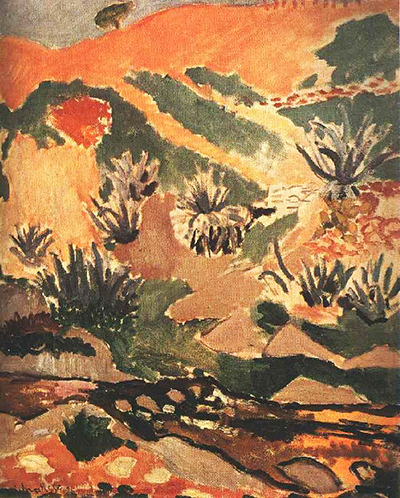Landscape with Brook is a 1907 creation, painted by Henry Matisse. Like in most of his other early creations, in this artwork, Matisse was inspired by nature. Here, the brook flows in the front view of the scene, without leading the viewer into an illusionistic space.
This work is one of his earliest paintings, showcasing figures alluding narratives in a classical and aerial perspective. In it are gradual transitions of light colours on the hillside, seen to change subtly from blues, greens and browns creating a soft harmony of hues. With the high horizon of the artwork, the lack of depth is emphasised, causing the viewer to focus more on the upward view than the inward. The scattered shades of colour convey a deep sense of silence, something that draws the viewer to a state of meditation.
Other Masterpieces
The Joy of Life, created between 1905 and 1906 is one of Matisse's most radical Fauvist works. Depicting the relatively traditional Arcadian landscape subjects, it placed him as a top leader of early modernism. While the subject is stylistic, it is considered controversial. By the sea and trees, Matisse portrays nude figures, while in the foreground are figures seen playing music and embracing.
Luxury, calm and pleasure is another of Matisse’s most dynamic and vibrant works, completed in 1904. It is a composition of conceptual meaning and Neo-Impressionist style, focused on leisure and fantasy, something that had not been seen before. Woman with a Hat marked the start of Matisse's expressive individual mode from his previous style of brushstrokes. Matisse encompassed loose brushwork and colours that appeared non-naturalistic. Created in 1905, this piece showcases a half-length portrait of his wife.
Green Stripe, a 1905 artwork by Matisse depicts a human face separated by a green line. It acts as a shadow, used to divide the face in portraiture style. The subject of the drawing is the focus on the two halves of the face, depicted in different colours. One of the halves is seen to portray pale greens, while the other has flesh tones. The combination of colours highlights what he feels for his wife and her personality.
A Glimpse of Notre Dame in the Late Afternoon is the other exemplary works created by Matisse. Completed in 1902, this artwork showcases a view from Matisse’s studio or apartment window in an afternoon setting. The painting is composed of dark colours, exhibiting what would then be described as Matisse’s darkest period of his life. One of the difficulties faced was the inability to sell his work, which made it hard for him to provide for his family. Making use of the representational palette, Matisse brought this work in a more impressionistic style.




